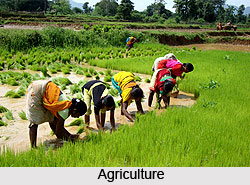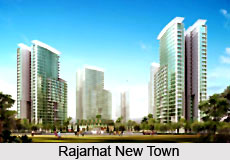 Agriculture is the main stay of the people of North 24 Parganas. The regional homogeneity with the sufficient rainfall is conducive for the prosperity of Agriculture. Agriculture supports the economy of North 24 Parganas, on a large scale. Rice, jute, coconuts, potatoes, wheat and rapeseed are the principal crops produce here. The orchard cultivation and horticulture supplements the economy to a desirable extent. Mangoes, Guavas and Bananas are exported on a large scale. In the post independence period the government, with collaboration of the Planning Commission, has undertaken a number of plans and schemes to upgrade the financial condition of the erstwhile rural areas. The Commission has taken up the task of opertionalisation of the agro-climatic regional planning.
Agriculture is the main stay of the people of North 24 Parganas. The regional homogeneity with the sufficient rainfall is conducive for the prosperity of Agriculture. Agriculture supports the economy of North 24 Parganas, on a large scale. Rice, jute, coconuts, potatoes, wheat and rapeseed are the principal crops produce here. The orchard cultivation and horticulture supplements the economy to a desirable extent. Mangoes, Guavas and Bananas are exported on a large scale. In the post independence period the government, with collaboration of the Planning Commission, has undertaken a number of plans and schemes to upgrade the financial condition of the erstwhile rural areas. The Commission has taken up the task of opertionalisation of the agro-climatic regional planning.
As the Planning Commission has pointed out the sole reason behind the poor rate of agriculture, during the 1950s is probably the unavailability of the superior quality of seeds. The farmers were in a weak position due to the plunder of the British in the pre-independence period. Hence when they left the land most of the farmers suffered as a landless subjects.
Even in the post -independence period, their financial condition was not in desirable state. Hence when the farmers of the other states like Punjab, Bihar, Orissa, and Haryana depend on the best quality of hybrid seeds imported from abroad, the farmers in West Bengal could not meet their demand. Planning Commission put forward the need to bridge the gap between supply and demand in their proposed scheme of subsided sale of quality seeds, thereby induce stability in the financial state of north 24 Parganas. The Government supplies fertilizer, which is one of the principal factors for the effective growth of agriculture. The Government provides the transport subsidy, for carrying chemical fertilizers to the inaccessible areas.
 To increase the coverage and the productivity of major crops, the Planning Commission has chalked out plans with the assistance of the district administrator. The schemes and the projects undertaken by the Government in the post independence period stimulated the economic growth of North 24 Parganas, by inducing agricultural development.
To increase the coverage and the productivity of major crops, the Planning Commission has chalked out plans with the assistance of the district administrator. The schemes and the projects undertaken by the Government in the post independence period stimulated the economic growth of North 24 Parganas, by inducing agricultural development.
Since North 24 Parganas is in close proximity with the metropolitan city Kolkata, the economy of Kolkata supports its economy to a large extent. A bulk of people in North 24 Parganas draw their living from the industrial sectors in the core of Kolkata. Moreover, the subsidiary industries are well developed in the pockets of North 24 Parganas. Food processing industries, some subsidiary schemes of the Haldia Downstream projects and quite a good number of agro-based industry supports the economy of North 234 Parganas. Moreover the construction of the Rajarhat New Town and the Sector V of Salt Lake city, as a seat of IT sector, enhance the financial status of North 24 Parganas. The Barrackpore sub division is the only developed part of North 24 Parganas, which alone accounts for the largest contribution in the economy of 24 Parganas.
In the post independence period, the economical growth of North 24 Parganas has become prominent with the collective expansion of the agriculture and industry.
More on West Bengal
| Tribes of West Bengal | Bengali Theatre | Temples of West Bengal | Colleges of West Bengal |
| Tribal jewellery of West Bengal | Bengali Language | Districts of West Bengal | Medical colleges of West Bengal |
| Airports in West Bengal | Crafts of West Bengal | Cities of West Bengal | West Bengal Cricketers |
| Monuments of West Bengal | Bengali Wedding | Personalities of West Bengal | Bengali Literature |
| Folk Dances of West Bengal | Bengali Folktale | Museums of West Bengal | Bengali Newspapers |
| Festivals of West Bengal | Bengali Cinema | Universities of West Bengal | Places to See in West Bengal |




















